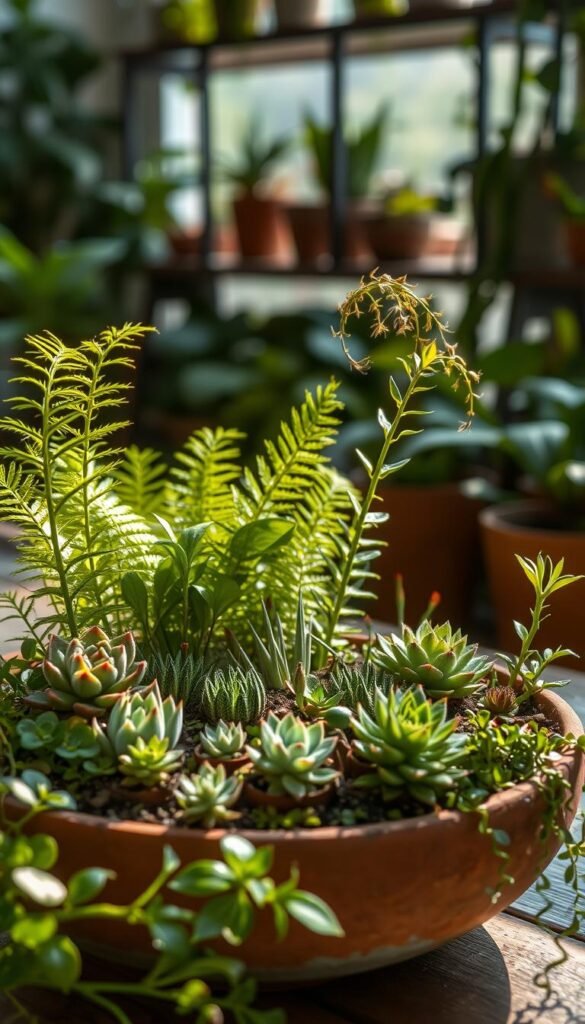Ever notice your favorite leafy companions looking a little droopy or spotted? You’re not alone. Keeping plants thriving in small, curated spaces requires attention to detail—and sometimes, a bit of detective work. This guide is your partner in nurturing a vibrant, healthy display, whether you’re a seasoned plant parent or just starting your green journey.
When leaves lose their perkiness or tiny invaders appear, it’s easy to feel overwhelmed. But spotting early clues—like subtle color shifts or slowed growth—can prevent bigger headaches later. We’ll show you how to decode these signals using methods that blend time-tested wisdom with up-to-date science.
No need for fancy tools or expensive treatments. Our solutions focus on accessible fixes, like adjusting watering habits or repurposing household items for pest control. You’ll learn to act fast, saving your arrangement from decline while boosting its natural resilience.
By the end, you’ll have a clear roadmap to revive struggling greenery and maintain its glow. Let’s turn those frowns (and wilted stems) upside down!
Identifying Warning Signs in Your Dish Garden
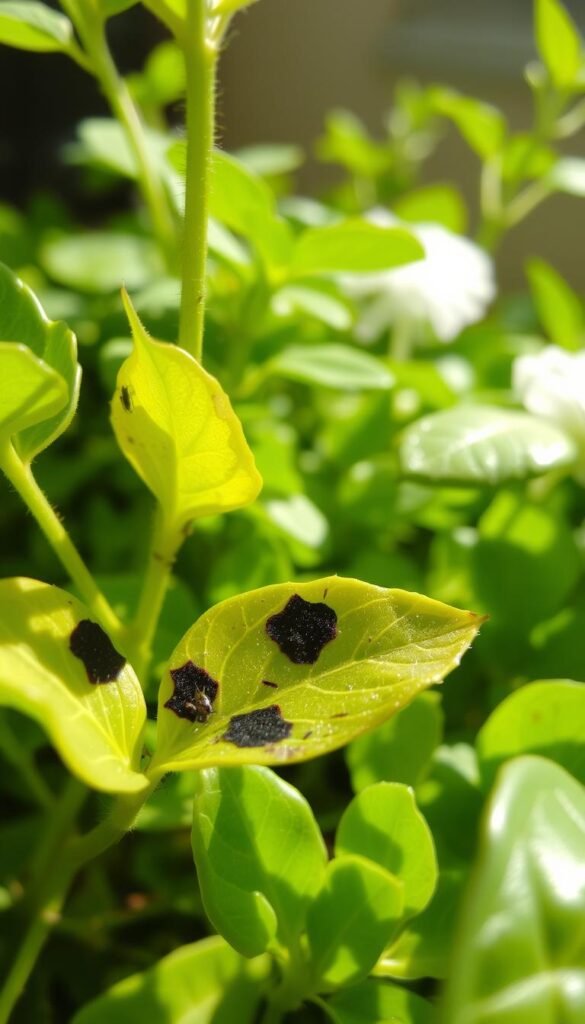
Catching the first whispers of plant distress is easier than you imagine. Your green friends communicate through visual cues—if you know where to look. Start by scanning foliage daily, focusing on color shifts and unusual patterns.
Observing Wilting, Discoloration, and Leaf Spots
Drooping stems or leaves often shout “thirst,” but persistent sagging suggests root issues. Check soil moisture before watering—overdoing it invites fungal guests. Yellowing usually points to hungry plants needing nutrients, while crispy brown edges beg for humidity adjustments.
Spotty leaves? Act fast. Circular marks with halos often mean fungal parties. “Powdery mildew looks like flour dusted on foliage,” one urban gardener notes. Isolate affected plants immediately to stop spore spread.
Recognizing Early Pest Activities
Turn leaves over—that’s where tiny troublemakers hide. Look for sticky goo (aphid residue) or silvery trails (thrips at work). Spot one whitefly? There’s likely an army brewing. Healthy plants repel bugs better, so boost their strength through proper feeding.
Webbing between stems? Spider mites might be spinning trouble. Crush a leaf—if it smells bitter, your plant’s already fighting back. Early detection lets you wipe out invaders with simple soap sprays instead of harsh chemicals.
Troubleshooting Common Dish Garden Problems: Wilting, Pests, and More
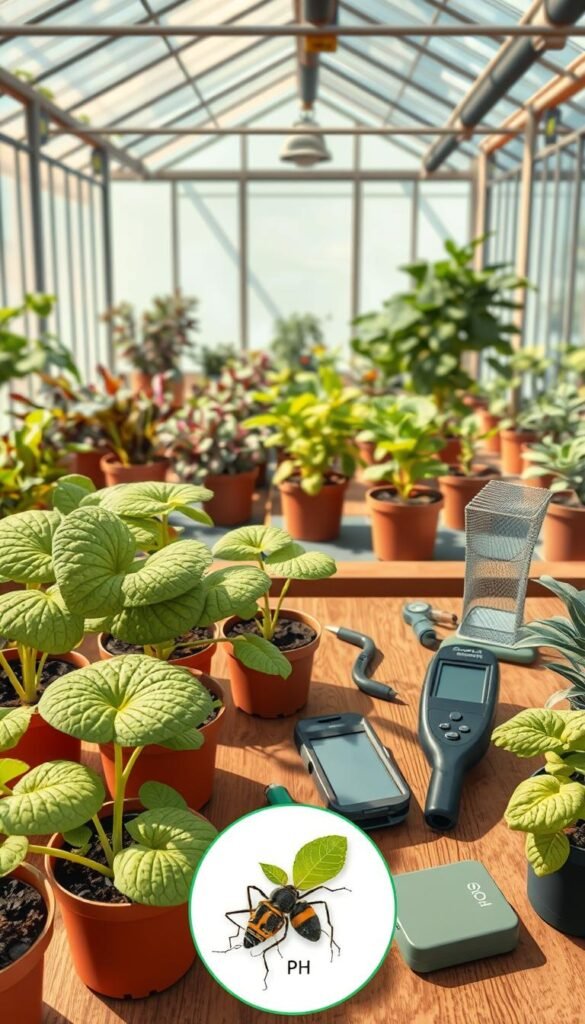
When your greenery starts acting off, it’s time to play plant detective. Start by gathering clues – a sticky leaf here, a yellow patch there. These subtle hints reveal what’s happening underground and in the air around your green companions.
Steps to Diagnose Plant Health Issues
Use this three-step checkup method:
| Symptom | Check | Action |
|---|---|---|
| Drooping leaves | Soil moisture & root color | Adjust watering frequency |
| Spotted foliage | Undersides of leaves | Isolate plant immediately |
| Stunted growth | Light exposure levels | Rotate or relocate plant |
Track changes daily in a notebook. Note patterns like “browning tips after fertilizing” or “perkier leaves after moving to east window.” This helps spot environmental triggers.
Immediate Remedies to Save Affected Plants
For urgent cases:
- Snip damaged leaves with sterilized scissors
- Create a humidity tent using clear plastic bags
- Swap watering cans for ice cubes to control moisture
One urban gardener shares: “I saved my fern by moving it three feet away from the heater overnight.” Quick tweaks often stabilize plants while you plan bigger fixes. Remember – healthy specimens fight off disease better than stressed ones.
Managing and Preventing Fungus and Blight
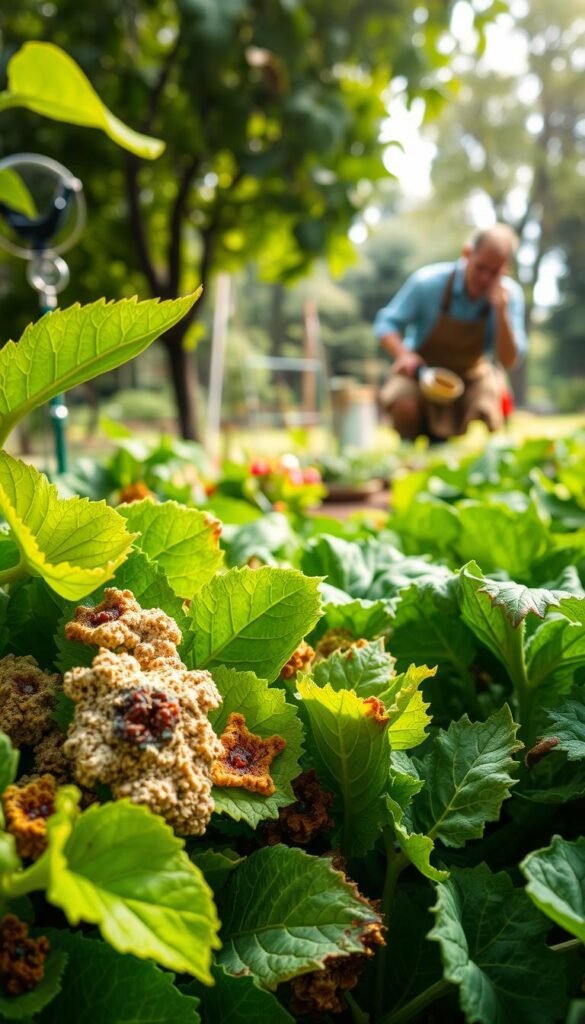
Spotting fuzzy invaders on your plants? Fungal issues don’t have to spell disaster. Whether you’re growing juicy tomatoes or hearty potatoes, understanding these sneaky threats helps you act before crops may die. Let’s tackle two big offenders: the dusty intruder and the rapid destroyer.
Treating Powdery Mildew and Fungal Infections
That white powder on leaves isn’t flour—it’s powdery mildew setting up camp. Mix 40% milk with water and spray affected stems and foliage every 10 days. For squash or cucumbers, this works like magic. Prefer soap? A 2% dish detergent solution breaks down mold without harsh chemicals.
Keep plants spaced like polite party guests. Crowded greenery traps moisture—a VIP pass for spores. One gardener swears: “Pruning my roses improved airflow and stopped mildew in its tracks.”
Prevention Techniques for Late Blight in Tomatoes and Potatoes
Late blight turns tomato and potato dreams to mush. Water only the soil—never leaves—using drip irrigation or a watering can with a long spout. Cool nights? Skip evening watering entirely. Remove fallen leaves daily; they’re spore hotels.
Rotate crops yearly. If blight strikes, destroy infected plants immediately. As one farmer advises: “Burn or bag them—never compost blighted plants.” Copper-based fungicides applied early can save remaining crops when paired with dry foliage practices.
Addressing Soil and Watering Challenges

Healthy plants start from the ground up—literally. Your greenery’s success depends on what happens beneath the surface. Let’s dig into creating the perfect foundation for thriving growth.
Evaluating Soil Quality and Nutrient Deficiencies
Soil testing is your secret weapon. A simple kit reveals pH levels and missing nutrients like phosphorus or calcium. Blossom end rot in tomatoes? Often caused by uneven watering disrupting calcium absorption, not soil shortages.
Boost soil texture with compost or aged manure. These organic heroes improve drainage while feeding roots. One gardener shares: “Adding peat moss transformed my clay soil into a plant paradise in one season.”
Optimizing Watering Practices and Drainage
Water deeply but less often. Shallow sprinkles create lazy roots that can’t reach nutrients. Use the screwdriver test—if it slides easily 6 inches deep, your watering works.
Improve drainage by mixing perlite into heavy soil. Overwatering drowns roots, starving plants even in fertile ground. Consistent schedules prevent calcium issues better than sporadic soaking.
Remember—avoiding common beginner mistakes starts with understanding your soil’s needs. Pair smart watering with nutrient-rich earth, and watch your plants dig their new home!
Effective Pest Management Techniques
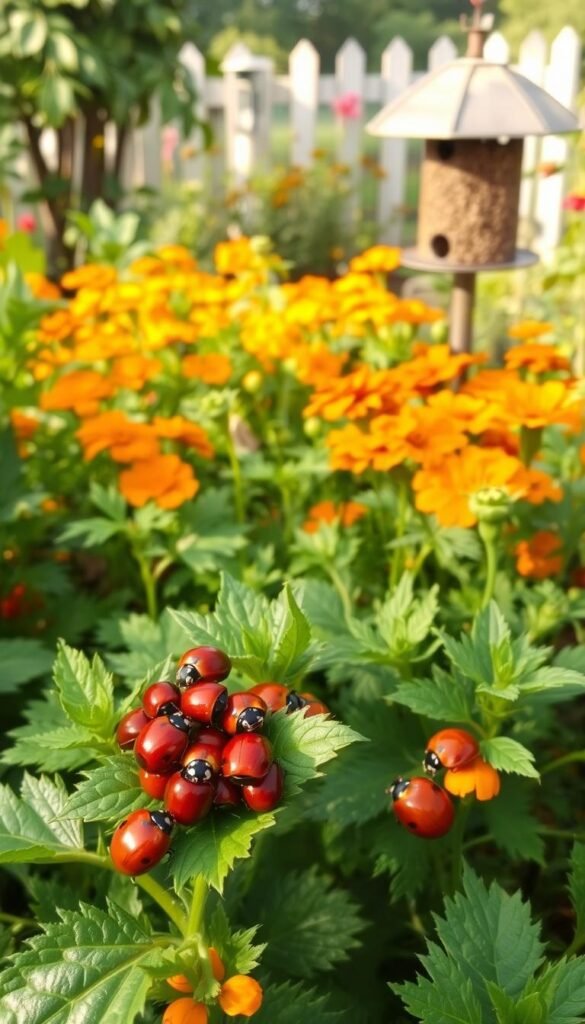
Outsmarting plant invaders starts with smart strategies. Whether you’re battling tiny sap-suckers or armored beetles, nature-friendly solutions keep your greenery thriving without harsh chemicals. Let’s explore proven methods to protect your plants while maintaining ecological balance.
Natural Remedies for Aphids, Stink Bugs, and Insects
Dish soap solutions remain a go-to fix for soft-bodied insects like aphids. Mix 1 teaspoon of mild liquid soap per quart of water—spray undersides of leaves where pests congregate. One gardener reports: “This vintage trick eliminated my aphid problem in three days!”
For stink bugs and flea beetles, try these approaches:
- Handpick adults early morning when they’re sluggish
- Plant trap crops like radishes to lure pests away
- Apply neem oil to disrupt their life cycle
Attract ladybugs by planting dill or marigolds. These spotted helpers devour up to 50 aphids daily!
Integrated Pest Management (IPM) Tips
IPM combines multiple defenses for lasting results. Start by monitoring plants weekly—check stems and leaf joints for eggs. Remove fallen leaves where insects overwinter. Natural solutions work best when paired with prevention.
Create your IPM plan:
- Identify pests using magnifying glasses or phone cameras
- Choose targeted treatments (soaps for aphids, row covers for beetles)
- Introduce predator insects like lacewings
- Rotate plants annually to break pest cycles
Remember: Healthy plants resist invasions better. Strengthen your greenery with proper feeding and spacing to minimize pest attractions.
Avoiding Plant Stress for Vigorous Growth
Pruning isn’t just cutting—it’s a conversation with your greenery. When done right, it encourages healthy growth while preventing disease spread. Let’s explore how strategic care keeps your plants thriving through seasons.
Proper Pruning and Planting Strategies
Sharp shears make all the difference. Dull tools crush stems, inviting infections. Always disinfect blades with rubbing alcohol between plants—it’s like giving each one a fresh start.
Time your cuts wisely. Spring-flowering shrubs set buds on old wood, so prune after flowers fade. Summer bloomers? Trim in early spring to boost new growth. One rose enthusiast shares: “I doubled my blooms by waiting until forsythias flowered before pruning.”
Managing Environmental Stress and Nutrient Imbalances
Leaves don’t lie. Yellowing between veins signals iron deficiency, while purple tints hint at phosphorus shortage. A simple soil test reveals what’s missing—fix it with targeted fertilizers.
Shield plants from extremes. Use shade cloth during heat waves and burlap wraps in frost. Mulch acts like a thermostat, keeping roots cool in summer and cozy in winter. Space plants properly—crowding stifles air flow and invites trouble.
Remember: stressed plants attract pests. By maintaining consistent moisture and nutrients, you create vigorous growth that naturally resists invaders. Your garden becomes a fortress of health, one thoughtful snip at a time.
Enhancing Garden Health with Preventative Care
Think of your garden as a living puzzle where each piece supports the whole. Smart planning today means fewer headaches tomorrow. A stitch in time saves nine—especially when working with earth’s natural rhythms.
Crop Rotation and Regular Soil Testing
Move plant families to new spots each season. Tomatoes and potatoes? Keep them away from last year’s bed. This breaks disease cycles hiding in soil. Squash relatives like cucumbers follow the same rule—rotate crops every 2-3 years for best results.
Test earth every spring. Simple kits reveal missing nutrients or pH swings. One gardener found her zucchini thrived after adding lime to acidic ground. Balance feeds plants while starving harmful microbes.
Using Organic Supplements and Maintenance Best Practices
Feed dirt, not just fruits vegetables. Compost and aged manure build rich, crumbly earth that holds moisture. These natural boosters work slowly, creating lasting health rather than quick fixes.
Mark calendars for seasonal checks. Track changes in leaf color or yield—they whisper secrets about soil needs. A Midwest grower doubled berry harvests by switching from synthetic to fish emulsion fertilizer.
Remember: Healthy ground grows resilient crops. Pair rotation with organic care, and your garden becomes a self-sustaining powerhouse season after season.

